Salmon fishing is always a fun experience for me, with all my mind active in the water, engaged me in a battle of strength. Their fierce resistance turns the water into a battlefield. It’s the battle between man and nature; I’m determined to prove my mettle as I hold on tight, each electrifying twist and turn. But the adventure doesn’t end here; the taste takes you into heaven; the word’ can’t describe the divine flavour.
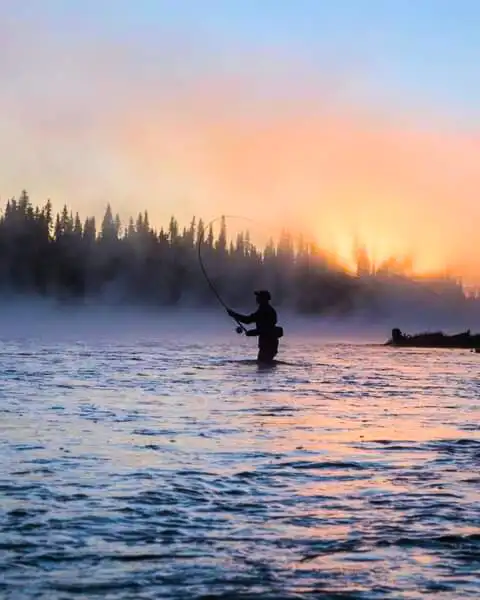
Salmon fishing tips:
PRO TIP 1:
Get ready before going out: Yes! Catching a Salmon is like a battle; you must prepare before you go for an intense fight. Take all your fishing gear with you.
PRO TIP 2:
Polish and strengthen your hook. Trust me! Sharpening your hooks can significantly increase the chances of the best experience, as Salmon have thick and strong jawlines. So, in that case, if your hook is fragile and not that sharp, you will end up frustrated.
Your hook should be Sharp. Right!
PRO TIP 3:
Picking the correct Bait can make all the difference. Using eggs is highly effective, but there are other options, like cutting Bait with a natural scent and movement or spooning thin artificial lures to mimic the fish’s movement.
PRO TIP 4:
Remember to add flash. Salmon are attracted to low lighting or flashes in deep water; the moment has proven to be a game changer in attracting the Salmon.
PRO TIP 5:
I prefer the red line: in the light of science, the colours fade as they go deeper into the water. Among all colours, red is the first one to disappear. Red can vanish at almost 15 ft in water, making the Salmon less likely to spook. Therefore, red lines appear to be a more natural presentation, but sockeye salmon is an exception, by having the ability to see red colour in water.
PRO TIP 5:
Prefer vibrant colour lures: when fishing below 50 ft., opt for lures in shades purple, green, blue, or UV. This colour tends to be visible in darker depth, making it stand out and attract the Salmon.
PRO TIP 6:
Go on overcast days: salmon-like low light or cloudy days. The best time of the day is early morning or evening when the light is relatively low. However, when the visibility is high, the Salmon becomes more cautious and less likely to strike.
PRO TIP 7:
The drift fishing technique is used in rivers or in dealing with currents. The drift fishing technique is discussed later in this article. In open water, fishing with tide flow is a crucial strategy.
PRO TIP 8:
Timing is a game changer; an hour before and after low or high tide is the favourable time to cast your line. During these peak timings, the water movement and condition are optimal for attracting Salmon.
Well…
Salmon fishing is prevalent among anglers in Northern California, extends to the Pacific Northwest, and continues into the State of Alaska. These regions are gaining attention from anglers worldwide for Salmon fishing.
Fisheries management has been actively introducing anadromous species of Salmon, like Chinook and sockeye, to the lakes and reservoirs of the US, involved in stocking Salmon in lakes. They spend their life in freshwater, rather than migrating from one water body to another, in a specific life stage.
Kokanee salmon is a landlocked version of sockeye salmon species, are known for being fierce fighters, and are highly sought after by anglers, especially in landlocked states.
Fisheries management aims to increase fishing opportunities and enhance the diversity of fisheries in both West Coast water storage reservoirs and the Great Lakes.
Before learning the techniques of how to catch Salmon, let’s discuss the types of Salmon.
Types of salmons:
Chinook or “King” Salmon:
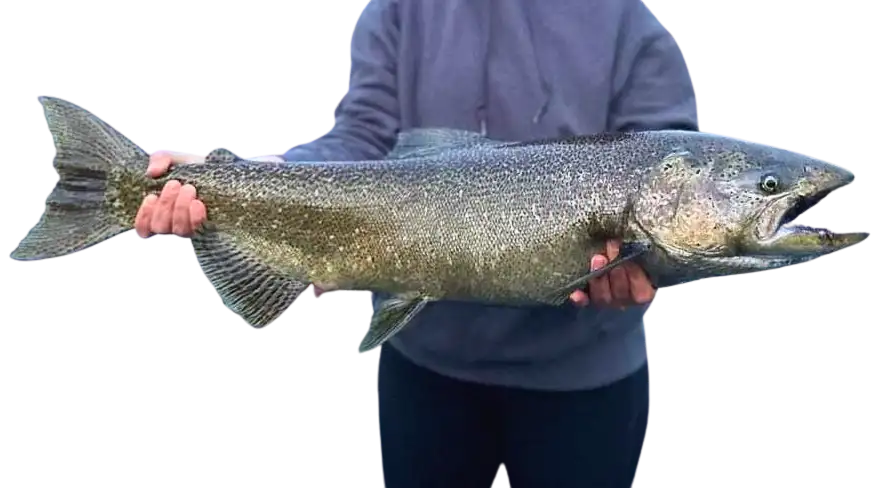
The significantly aggressive type of Salmon is known as King salmon, also called Chinook Salmon. They are the largest and most powerful of all the salmon species, with their average size ranging from 10 to 30 pounds. When they reach 40 pounds or more, they are considered large enough.
Despite their large size, king salmon are highly rewarded for their delicious taste and their challenging fights when hooked by me.
They live in the ocean but move to rivers and streams to lay eggs (spawn). In the sea, they are recognized by having a purple shade on the upper back, while silver sides have spots or lines inside the mouth.
Their physical appearance changes once they enter freshwater. The colour becomes darker with the development of red lines at their side.
They prefer to spawn in gravel beds made of medium or larger sizes in rivers and lakes. However, they are strong enough to push their way into smaller streams or even when the water is shallow. The experienced anglers see their large dark backs sticking out of the water as they walk through these streams.
Coho or “Silver” Salmon:
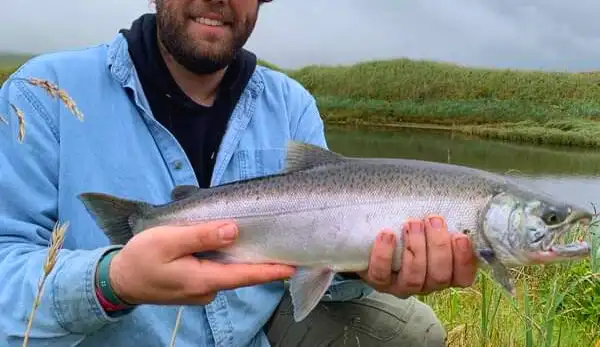
Coho salmon is also known as silver Salmon. They are often found in California. They’re heavily caught between the Central Oregon Coast and South-East Alaska. Silver
Coho salmon are mother to cold water from North America to Alaska, Northern Japan, and eastern Russia. Silver Salmon are born in freshwater, where they spend up to 2 years.
They live both in freshwater and ocean. In freshwater, their jaws develop, and their colour changes to reddish (maroon).
Coho salmon are considered gamefish by anglers because of their habit of bouncing out of water when caught, giving the sensation of electricity on the fishing line.
You can easily find them in the rivers, close to the coast. Some travel in groups far inland through rivers like Columbia, also used by chinook salmon.
They move towards the spawning grounds of rivers and are more likely to move into smaller streams. Other fish, such as trout or steelhead, might join them.
They are excellent jumpers, tackling hurdles on their way through the jump to reach the area for spawning.
As an angler, their interesting behaviour is waiting for a rainstorm to make their upstream journey. After the rain, water levels go up, and it is a favourable time for them to migrate upstream, filling the smaller rivers and overcoming obstacles like rocks, logs, or other barriers.
Sockeye or “Red” Salmon:
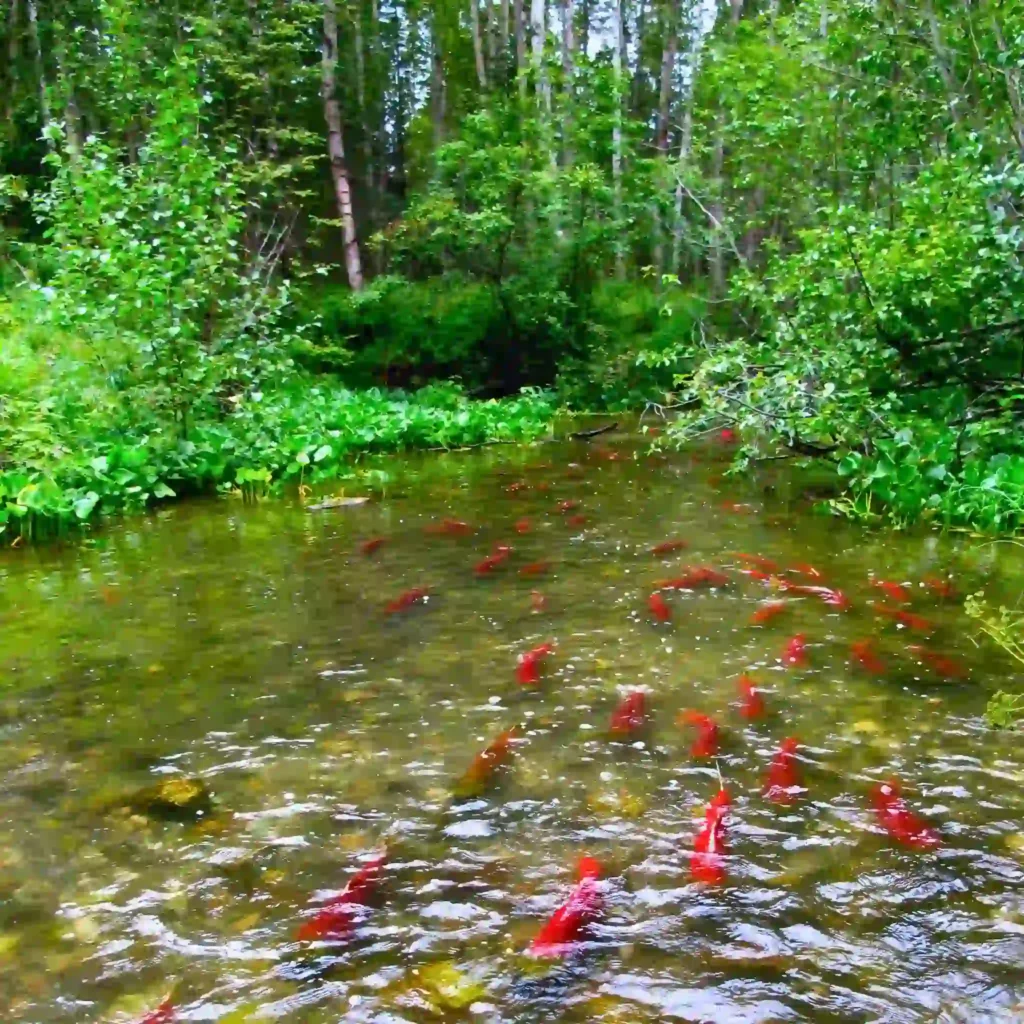
From Oregon to Alaska, these beauties tend to change colour to greenheads with red bodies when they’re ready to lay eggs. They swim upstream to their egg-laying grounds.
You might have also seen them in videos where Alaska bears catch them while jumping out of water. Remember!
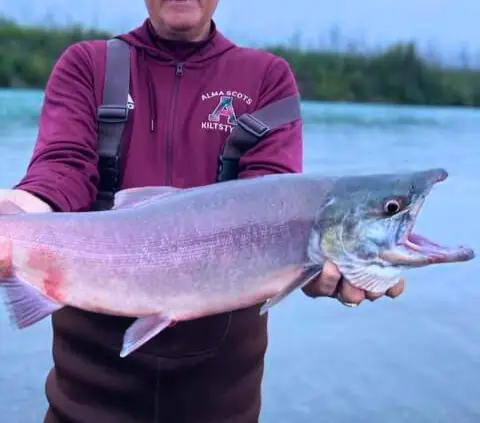
Sockeye is a big ocean version with a delicious taste, while a smaller version, Kokanee, lives in lakes and is equivalent to many trout types.
The west coast is enriched with Kokanee, where landslides don’t favour their migration. Wildlife management moved these fish to cold water lakes in mountainous and northern areas.
Big sockeye is widespread, especially in northern areas, because of its strong salmon flavour. They like to swim in big rivers and tend to lay eggs in mountain lakes. Their baby fish spend their lives in lakes before returning to their home ocean.
Pink Salmon:

Smaller than Coho and Chinook, with their humps, they appear every year in Washington to Alaska.
They are also known as “Humpies” or “humpbacks” because male pink Salmon produce a hump on their back at the time of spawn, yet they show up like clockwork every year.
Only smaller groups of pink salmon fish return to their birthplace during the colourful fall season every other year. Like in Washington, they visit their home in years with odd numbers like 2019, 2021, 2023, and will be in 2025, while they back in late summer.
Interestingly, more fish returning to their birthplace means more excitement for fishing enthusiasts. Still, in the past few years, there’s been a noticeable dip in the number of returning fish, marking a concern for these aquatic wonders.
They should lay eggs closer to the ocean. The reason is that they move quickly to seas after hatching.
Chum Salmon:
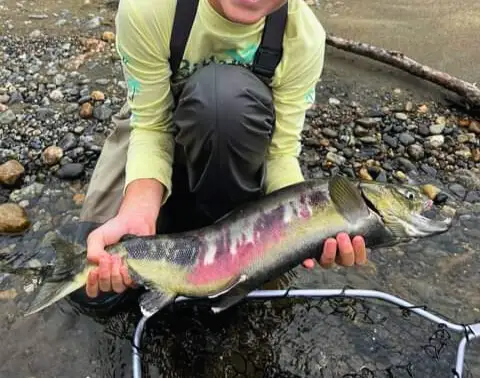
Chum salmon are like fish superheroes. They grow teeth that could make even a superhero jealous, especially at a time when they lay their eggs. This earns them the nickname “dog salmon,” maybe because they’re not the tastiest, and people thought dogs might like them as a meal.
But don’t be fooled by rumors! These fishes are way more fascinating than just their taste. They’re strategic geniuses. They choose to hang out closer to the oceans, the point of the beginning of the journey. When other Salmon bravely leap up waterfalls. Chum salmon, take the easy way. They love to travel through spots with no obstacles.
Silver-Brite, or keta, are different names companies give for selling purposes.
I wouldn’t say I like catching chum salmon. First, they are tough fighters with tastes not matched to exceptions. They fight to make your muscles ache and can even strain or break the fishing rod.
The fun fact is that they lay eggs at approachable places; your sight can easily reach there.
What to use for salmon fishing/ Salmon fishing Gear:
Taking Salmon fishing gear with you is necessary. The gears like fishing rods, reels, line, and leader come in the primary category, while the secondary category includes lures or baits and hooks; you need them everywhere, whether in freshwater or ocean.
It would help if you had another tertiary gear like a boat, bobber, and floating line when in the River, depending upon the location or fishing techniques for salmon fishing.
Each technique requires a proper setup and practice with patience.
One thing to remember is that the size of the fishing rod should be longer for shore fishing and boat fishing.
So, let’s discuss each technique one by one.
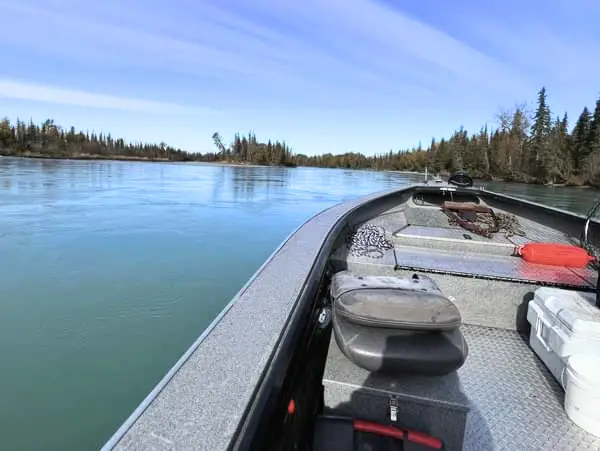
Salmon fishing techniques in different water bodies
[how to catch Salmon in a river]
Salmon fishing in the River is an easy learning way yet cost-effective. You can learn the salmon fishing secrets without getting too harsh on your finances.
When you have two options: fishing in a river or going to big oceans, I prefer the River. Why! Imagine you don’t have a fishing boat; fishing from the riverbank is the only option. You can have a blast without spending a ton.
But some salmon fishing river techniques require a boat. It would help if you had a proper setup for that. Moreover, getting the hang of salmon fishing can be like a puzzle. But not in the case when you’re in the River, you may have the facility to join the trip of fishing guides directly responsible for teaching you tricks. The approach is not dear to pocket with the benefits of making you learn faster to catch more fish in less time.
Guess what?
Rivers are often closer to your residence, saving you from hectic, longer travelling.
The most famous place in the USA for salmon river fishing is on the West Coast and around the Great Lakes.
Shoreline salmon fishing techniques; Drifting:
Drifting fishing is your go-to technique if you’re eager to reel in some salmon while fishing from the riverbank. It’s a popular method that lets you connect with nature while trying to land the big one.
First, you need the right tools, including a 9-foot fishing rod with a bit of flexibility, perfect for handling a 30-pound fishing line. You can go lighter with a 10- to 15-pound test line for smaller Salmon.
Now, let’s talk about the fishing setup. Attach a snap swivel to your mainline. This is like a little clip that makes it easy to switch things up. Then, tie a 24- to 48-inch leader to the swivel and attach a hook at the end. To make it enticing for the Salmon, add a Corky (a colourful drift bobber) above the hook and some yarn on the hook’s loop.
You’ll need some weight to make your setup sink and stay close to the riverbed where the Salmon like to hang out. Pencil weights are incredible because they can fit snugly into a rubber cover on the swivel. Slinky weights are another option; they tend to get stuck less often.
Salmon has a refined palate, and the right Bait can make all the difference. Some popular choices include cured salmon roe clusters and sand shrimp. The Chinook, a larger salmon species, can be incredibly picky, so having top-notch Bait is necessary.
With your gear set up, it’s time to hit the water. Cast your Bait upstream and let it drift down with the current. Keep a close eye on it as it moves downstream. Once it’s passed you and out of the prime fishing area (the “run”), cast it upstream again.
Now, it’s all about covering the entire pool from side to side. This means working your Bait from the closest side of the pool to the farthest side and from the top to the bottom. Salmon can be sneaky, so you want to explore all their hiding spots.
Keep drifting and trying different spots until you find the best holding water where the Salmon will likely be.
Side Drifting:
Side drifting is a fantastic twist on traditional drift fishing, especially when you’re out on a boat. It’s a strategy that can yield excellent results if executed correctly. The concept is simple: you cast your line while the boat drifts downstream, allowing you to explore more water. If you have multiple anglers on board, ensuring everyone uses the same setup for consistency is crucial. Start by casting your line upstream and let it drift until it’s just past the prime fishing area. Then, they threw upstream again. This technique involves working from the riverbank toward the pool’s centre, ensuring you cover every inch of water. Side drifting can be a thrilling way to increase your chances of landing impressive catches while enjoying a day on the water.
Plunking technique for salmon fishing:
One of the techniques for catching Salmon in the River is plunking, like setting a buffet for the fish.
For this, you’ll need a sturdy fishing rod (9 ft.), ensuring the rod is capable of handling heavy lines, usually around 50 pounds weight.
Salmon fishing gears you need for the plunking technique involve the attachment of a swivel or slider to the end of the line, keeping in mind to connect the leader of about 4 to 6 feet.
KwikFish is the critical lure for plunking, which you’ll dress up with a slice of baitfish, such as sardine, making it look extra tempting.
You can add a 2.5 to 3-foot leader, and a heavy weight to the slider or swivel combo will help keep the baited KwikFish its place.
Casting this setup into the River is similar to inviting passing Salmon.
That’s why, for anglers, it’s essential to choose the casting location very wisely.
I prefer slower and calm pools in the River, especially those just above fast-moving sections, where Salmon likes to rest.
Patience is the crucial factor of success in this technique. But you must be alert by watching the setup, waiting for a fish to bite.
Pro tip:
In a larger river, I prefer to target the slower edges of the main channel, where Salmon like to navigate.
Remember, Salmon are attracted to vibrant colours, so choose shades of lures like orange and pink.
Float technique for salmon fishing:
Float fishing, also known as bobber fishing techniques, is used to catch fish, including Salmon, when the water is still and calm by suspending your baby or lure at a particular depth using a buoyant device known as a bobber or Float.
Float fishing is commonly used in rivers during low-side times, fishing situations like big eddies, or when the tide isn’t vital.
The method uses a longer fishing rod, around 10 to 12 feet.
The speciality of this technique is known for using a particular line, also named spectra lines. These lines have a non-stretchable nature and can even float on water.
Salmon fishing gear you need for Float fishing includes:
- Fishing rod (10-12 ft.)
- Sliding Float
- Swivel or connector: this keeps the line from twisting or tangling up.
- Weight: you’ll need some weight to ensure the lines go through the Float. This weight below your Bait goes down to the desired depth.
- A leader is a short line between the main line and lures or Bait.
- The Mainline is a unique fishing line, also called the spectra line.
- Bobber stops and bead; this is attached to the line that helps you devise how deep it wants your Bait. At the same time, a tiny dot keeps it from falling off.
- Bait or the lure of your choice: I prefer salmon eggs on the top pick, sand shrimp for chinook salmon, or marabou jigs.
- Reel and hook
How to do Float or bobber fishing for catching Salmon:
Firstly, fix the bobber to your fishing line. The bobber will Float on the surface of the water. It can move along the line, which is neat. Then, you had a twist stopper to keep your line from getting all tangled up. Attach something a little heavy to your line to help your Bait enter the water, and Salmon can’t resist.
Next, connect a leader to the twist-stopper, and at the end of it, put your Bait or lure.
Choosing a perfect depth is necessary. Deciding how deep you want your Bait to be in the water
is essential.
The bobber stop helps you divide how deep your Bait should go, and the bead keeps it in place.
Slide the over-up or down the line to the desired depth. The rope below the bobber will hold your hook and bait underwater at the chosen depth.
Attached is your chosen Bait to the hook. I prefer using shrimp, roe, or artificial lures resembling their prey for salmon fishing.
If you’re fishing early in the morning, the fish might hang in the middle of the water when the sun hasn’t fully risen. So, set your bobber stop for that. But when the sun is up and shining, the dish tends to win closer to the bottom; you’ll need to change the bobber stop to make your Bait closer to the bottom, too.
Pro tip:
In case of moving water, you must adjust your line by lifting or flipping it. This makes your line straight, which helps when a floating thing goes underwater.
I’ve spent some serene moments practising bobber fishing for Salmon. It’s similar to inviting nature to be your co-partner. With your special gear and a bit of practice, you’ll master salmon fishing. Be bold, adjust the bobber stop, and give your line a little grooming if the water’s tricky. So, give it a shot!
Trolling technique for salmon fishing:
If you like eating sockeye and kokanee salmon, you must be familiar with trolling techniques. When the River is large, the trolling approach works wonders.
For setup, you need a boat that moves in water. A 20-25 pounds test line, and 4-8 ft., leader.
The choice of Bait depends upon the location and species present.
Imagine you’re out on the boat, and you need to pick the right kind of Bait; depending upon the type of Salmon and where you are, I suggest you choose cut pieces of herring or shiny lures that dance in the water.
When on the boat, you need to check the depth of water. Salmon swim at different levels in the water, so ensure that the Bait reaches the correct depth. Planner boards are used for these purposes. I often use weights or downriggers like anchors for our fishing line.
Adjust the speed of the boat, both slow and fast enough. A steady motion drags the Bait through the water, covering a larger area and increasing the chances of finding Salmon.
I don’t randomly drive around, though. I know that the Salmon like to hang out in certain spots, like areas with good food sources or at water temperatures. So, I navigate the board back and forth in these promising spotsalso called “runs,” in the hope of catching Salmon.
Pro tip:
For making your Bait more appealing, use in-line flashers. These are shiny toys for Salmon. You can attach them to the flashing line just above the Bait. With every move, these flashes twirl and reflect sunlight, creating a sparkling display in the water. This resulted in movement and shine catching the attention of Salmon.
Importance of Casting Spinners and Spoons:
Salmon fishing with two valuable tools, like spinners and spoons, offers effectiveness.
Casting spinners:
Spinners, those weighted lures favoured by salmon anglers, and here’s a secret- they work wonders even in clear and shallow water.
The magic lies in the vibrant, attention-grabbing colours of spinners that my father uses to create irresistible vibrations beneath the surface.
Now, here’s the kicker: they are not in the mood to dinning during Salmon’s spawning runs. That’s where your angler’s fineness comes into play- you’ve got to provoke those Salmon into biting. To do this, cast spinners into backward eddies and areas with gentle current. The retrieval speed adjusted with water conditions adjusted to slower retrieves in solid winds.
When fishing in rocky waters, prevent snagging by quickly wrist snapping at the start if retrieved.
Here’s the plot twist: these fish can be as sly as foxes. They might try your spinners across various currents, almost teasing you before they finally strike. It’s all part of the game, and you’ll soon learn to play alone, like me. The colours of your spinners should mirror the stage’s lightning-bright and light for clear waters but dark and mysterious for overcast or low-light situations.
Casting spoons:
Moving on to spoons, these are too productive for salmon fishing. But why? Because they trigger the Salmon’s aggression even when they aren’t actively feeding.
There are many spoons available with different styles and types. So, choose the right size and colour that compliments your technique and water conditions
, whether spinners or spoons.
Regarding reeling in those Salmon, the speed at which you retrieve your lure is like a secret code. Sometimes, it’s all about going with the flow, letting your Bait drift naturally with the current.
Other times, you should go for a slow and steady approach, as if whispering sweet nothings to those Salmon. But there are moments when you need to turn up the heat, go fast and twitchy, as you’re saying, come and get it, you fierce fish!”
Be bold and experiment; it’s like trying different dance moves until you find the one that gets you in sync with the Music. Once you’ve got that rhythm down, start close to the shore in shallow water, testing the waters. They step out and keep moving, covering every inch of that section like a detective on a hot trail.
Wobbler fishing:
If you ever hunt for chinook salmon, you might know those creatures prefer to hang out in the deeper water near the bottom. To reach them, you need a weapon; that’s where the Wobbler helps you.
The Wobbler setup is a bit like your fishing ensembles, with a few key elements. You have a five ft. line with a weight dropper and a five ft. Leader.
This setup allows your Bait to reach the depth where the Chinook is hiding.
But here’s where things get interesting: the amount of lead you use can vary, depending on the water’s depth and how it’s flowing; you might need anywhere from 2 to 24 (ounces) of lead to make sure your lure stays near the bottom where Salmon is lurking.
Wobbler has a unique action miming prey movements, making it so effective in luring those Salmon.
Pro tip:
Fishing in larger rivers near the oceans, there’s something to watch. Tides are a game changer. Notice that water’s flow influences the speed of Wobbler’s action, and tides can shift things. You want the right amount of current to make the Wobbler work its magic. Too much, and it becomes a wild ride; too little, and it’s like hitting pause. So, finding that spot is a task.
Anchor fishing:
Anchor fishing is a simple yet effective strategy. How? You simply drop an Anchor while carefully selecting a Kwikfish or any similar plug, generously wrap it up with irresistible Bait, and cast it into those strategic spots where you suspect Salmon are lurking below.
Anchor serves as your true friend, helping you to keep an eye on prime locations.
Now, onto the main attraction: when you deploy one properly, these fish can’t resist the temptation.
But here’s the clever twist: add an extra layer of allure by wrapping the plug-in bait. To do so not only makes the plug more enticing but also releases a tantalizing scent into the water. Similarly, throwing a detectable aroma party underwater and the Salmon are the honoured guests.
Anchor fishing and back trolling are like a dynamic duo for salmon fishing effectively being done. Trolling lets you slow down your boat precisely where the Salmon are hanging out.
Salmon fishing in lakes:
A plentiful population of Salmons live in lakes initially introduced from the Pacific Northwest, along with some Atlantic Salmon.
The fish migrate up fantastic rivers, stretching from Michigan to New York, to spawn.
Salmons take up residence in lakes and grow to impressive sizes. We have resilient sockeye salmon that can spend a year or more in the calm water of lakes before embarking on their journey to the vast ocean. And guess what? Anglers have the perfect chance to target them.
You’ll find another gem in the Western States- the kokanee salmon. They are powerhouses and abundantly present in specific lakes.
Anglers in the know flock to places like Baker and Wenatchee lakes in Washington to reel in these beauties. The best part? Kokanee’s Fishing techniques are similar to those for sockeye, with slightly beefier tackle.
Some of the State’s fish and wildlife agencies, like those in Washington, Oregon, and California, have introduced Chinook and cohort salmon into large lakes and reservoirs. When these lakes lack a direct route to the ocean, these Salmon stick around and grow bigger.
Trolling helps when it comes to snagging Salmon in lakes.
Imagine cruising on a calm lake, strategically trailing your lures through the water, enticing those Salmon to bite.
For Kokanee and sockeye, fishing is based on using small or medium-sized spoons, spinners, and lures, often sweetened with a tasty piece of Bait. It’s like presenting them with a detectable menu; they can’t resist.
These lure types can also work their charm on freshwater Chinook and Coho but prefer larger sizes.
Salmon living in lakes often prefer the deeper waters, sometimes even more profound than the trout swimming alongside them. The tools like downriggers, divers, or extra weight help you to react at that point.
Flashers also come into play, grabbing Salmon’s attention. The speed and depth of trolling may vary by location, but with solid setup.
Fly fishing for Salmon:
Fly fishing for Salmon is an adventurous Experience, but it’s essential to know that a specific type of Salmon has its approach to target.
Coho and Chinook Salmon are attracted by streamers, especially if they drive deep and sports vibrant colour.
On the other hand, sockeye salmon won’t strike at a fly. Instead, a clever technique involves pulling the line through their mouths to hook them with a fly. It’s like luring them into a gentle trap.
Your standard trout rod won’t fit; you’ll need a salmon fly fish rod set up that includes A 13 ft. Rod is an ideal choice, helping you cast farther by providing the backbone for the lengthy battles it might take to land a salmon, sometimes up to 25 to 30 minutes.
For the fly reel, make a wise investment and ensure it comes with an extra spare spool. Start with a floating line and keep a sinking line on the spare for versatility.
When it comes to Fly selection, pack a variety. Small salmon flies, sizes almost 10 to 12, perfect. But also take with you flies range from size 12 to 2. Bring a few more oversized and heavy streamers for targeting deeper in the water. Chinook salmon are more attracted to more extensive and deeper flies, while solvers might prefer shallow, smaller ones.
For battle, Coho salmon is well known for giving the most thrilling fight. They behave like trout or steelhead, putting on acrobatic displays and leaving out of the water.
Now, leaders are critical in salmon fly fishing. Learn the rule of thumb: smaller flies require longer leaders and lighter tippets. In clear water, prefer for the thinner tippet allows you to land the fish successfully.
Salmon fishing in saltwater:
Salmon fishing in saltwater is challenging; you should know some tricks that might help you in water.
Watch for birds; the most basic trick is to keep an eye on birds. They are like nature’s GSP for finding baitfish, and where there are baitfish, Salmon are often close by. Birds will gather in groups when there’s the possibility of food, but sometimes, they hang around before during a feast.
In the sea, people in many boats use the same technique: trolling.
Trolling is a highly effective method to get you to the proper depth; downriggers are usually the way to go unless the Salmon swim near the surface, as discussed above.
The Downrigger setup is straightforward. You attach a barrel swivel to your main fishing line, then add about 6 ft of heavier monofilament fine to your flasher. Below the flasher, add around two ft. of lighter fluorocarbon line. At last, tie-on hour lure or hook, add some cut bait (like plug-cut herring), and you’re ready to roll. Plug-cut herring is a popular bait choice. You missed the head off the herring at an angle just behind the gill plate to do it right. The rise of the cut affects how the bait rolls in the water, making it look like an injured fish, a tempting treat for Salmon.
Additionally, pay attention to spinners and plugs designed for trolling, as they can be highly productive.
Try another technique, mooching, which involves lowering hour bait just below the depth where the Salmon are lurking and then reeling it in slowly towards the surface. It’s an attractive movement that can provoke Salmon into striking.
When fishing in bays and inland waterways, watch for these prime locations, especially during salmon staging periods before they head upstream to spawn. Here, trolling with Bait or lures is common, and you’ll generally need to fish shallower than in deeper waters. Casting spoons and spinners can add an exciting element to your fishing experience in shallower waters. Look for smaller bays and inlets near tributary rivers for tight conditions that often host Salmon.
Another productive tactic is targeting tidewater areas where Salmon pause just before entering rivers. Using Bait, such as cured salmon roe under a bobber, can work wonders in these spots.
Pro tip:
Remember the power of scent if you’re marking Salmon but not getting bites. A little perfume on your lure can make a big difference in attracting Salmon to your presentation.
Where to fish Salmon in the USA:
Salmon fishing is most popular in the USA; people love fishing. Let’s discuss some of the most famous spots in the USA for salmon fishing.
Washington Rivers:
Columbia River
Chehalis River
Sol Duc River
Cowlitz River
Humptulips River
New York:
Salmon River (timing, late August to early October)
Lower Niagara River (timing, between September to November)
Lake Ontario (timing, between May to October)
California:
Rivers:
Sacramento River, Feather River, Smith River, Klamath River, Trinity River, and Eel River.
Lakes:
Trinity Lake, Shasta Lake, Lake Oroville, Folsom Lake, Don Pedro Reservoir, Lake Almanor, Lake Berryessa.
Michigan:
Manistee River (timing, mid-August to October)
ST. Mary’s River (timing, mid-August to October)
Alaska:
Lower Kenai River (timing, May to June for early Kings, July for late Kings and sockeye Salmon, August to October for silver Salmon.)
Middle Kenai River (timing, July for sockeye salmon, August to October for silver Salmon.)
Upper Kenai River (timing, mid-June to end of June for sockeye salmon, August to October for silver Salmon)
Kasilof River (timing, made May to mid-September)
Homer, Alaska; (timing, mid-October, to end of April)
